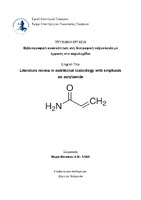| dc.contributor.advisor | HOUHOULA, DIMITRA | |
| dc.contributor.author | Μενοίκου, Μαρία | |
| dc.date.accessioned | 2023-10-26T10:16:28Z | |
| dc.date.available | 2023-10-26T10:16:28Z | |
| dc.date.issued | 2023-09-29 | |
| dc.identifier.uri | https://polynoe.lib.uniwa.gr/xmlui/handle/11400/5490 | |
| dc.identifier.uri | http://dx.doi.org/10.26265/polynoe-5327 | |
| dc.description.abstract | Θέμα της παρούσας πτυχιακής εργασίας είναι η βιβλιογραφική ανασκόπηση στη
διατροφική τοξικολογία με έμφαση στο ακρυλαμίδιο. Η τοξικότητα ενός τροφίμου
αναφέρεται στην παρουσία ουσιών που είναι επιβλαβείς για τον άνθρωπο, όπως
θρεπτικά συστατικά, φυσικές τοξικές ουσίες, ενδογενείς τοξίνες ή/και ενώσεις που
παράγονται κατά τη διάρκεια της επεξεργασίας του τροφίμου. Η έκθεση ενός τροφίμου,
πλούσιου σε υδατάνθρακες, σε υψηλές θερμοκρασίες για μεγάλο χρονικό διάστημα
εμπεριέχει τον κίνδυνο να οδηγήσει στην παραγωγή μίας ουσίας με έντονη
τοξικολογική δράση, του ακρυλαμιδίου. Το ακρυλαμίδιο έχει ανιχνευθεί σε σημαντικές
ποσότητες σε διάφορες κατηγορίες τροφίμων, όπως στις τηγανιτές πατάτες, στα τσιπς
πατάτας, στο ψημένο ψωμί, στα μπισκότα και στον καφέ. Η διατροφική έκθεση ενός
ατόμου στο ακρυλαμίδιο εξαρτάται από το είδος και την ποσότητα των τροφίμων που
καταναλώνει. Επιπλέον, σύμφωνα με τα υπάρχοντα επιστημονικά δεδομένα, έχει
δυνητικά καρκινογόνα και νευροτοξική επίδραση σε έναν οργανισμό, ενώ ανιχνεύεται
και στο μητρικό γάλα, απ’ όπου μπορεί να περάσει στο βρέφος θέτοντας σε κίνδυνο
την υγεία και την ανάπτυξή του. Τέλος καταβάλλονται προσπάθειες για την ανάπτυξη
στρατηγικών που θα ελαχιστοποιήσουν το παραγόμενο ακρυλαμίδιο, οι οποίες
διαφοροποιούνται ανάλογα με την πρώτη ύλη, τις συνθήκες επεξεργασίας και τις
επιλογές της μονάδας παραγωγής ενός προϊόντος. | el |
| dc.format.extent | 65 | el |
| dc.language.iso | el | el |
| dc.publisher | Πανεπιστήμιο Δυτικής Αττικής | el |
| dc.rights | Αναφορά Δημιουργού - Μη Εμπορική Χρήση - Παρόμοια Διανομή 4.0 Διεθνές | * |
| dc.rights | Attribution-NonCommercial-NoDerivatives 4.0 Διεθνές | * |
| dc.rights.uri | http://creativecommons.org/licenses/by-nc-nd/4.0/ | * |
| dc.subject | Διατροφική τοξικολογία | el |
| dc.subject | Τοξίνες | el |
| dc.subject | Τοξικές ουσίες | el |
| dc.subject | Ακρυλαμίδιο | el |
| dc.title | Βιβλιογραφική ανασκόπηση στη διατροφική τοξικολογία με έμφαση στο ακρυλαμίδιο | el |
| dc.title.alternative | Literature review in nutriniotal toxicology with emphasis on acrylamide | el |
| dc.type | Πτυχιακή εργασία | el |
| dc.contributor.committee | Αντωνόπουλος, Διονύσιος | |
| dc.contributor.committee | Kanellou, Anastasia | |
| dc.contributor.faculty | Σχολή Επιστημών Τροφίμων | el |
| dc.contributor.department | Τμήμα Επιστήμης και Τεχνολογίας Τροφίμων | el |
| dc.description.abstracttranslated | The subject of this thesis is the literature review in nutritional toxicology with an
emphasis on acrylamide. The toxicity of a food refers to the presence of substances
that are harmful to humans, such as nutrients, natural toxic substances, endogenous
toxins and/or compounds produced during the processing of the food. The exposure
of a food rich in carbohydrates to high temperatures for a long time involves the risk
of leading to the production of a substance with a strong toxicological effect,
acrylamide. Acrylamide has been detected in significant amounts in several food
categories, including French fries, potato chips, baked bread, cookies and coffee. A
person's dietary exposure to acrylamide depends on the type and amount of food they
eat. Efforts are being made to develop strategies that will minimize the acrylamide
produced, which vary according to the feedstock, processing conditions, and plant
options for a product. Acrylamide, according to existing scientific data, has a potentially
carcinogenic and neurotoxic effect on an organism, while it is detected in fetuses,
where it creates an increased risk of affecting the development of infants. Finally, it
has been detected in breast milk, from where it can pass to the infant, endangering its
health and development. | el |


